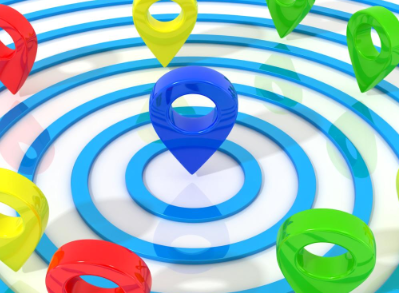Bluetooth positioning technology, with its advantages of low power consumption, low cost, and easy deployment, has become a core solution for scenarios such as indoor navigation, asset tracking, and personnel management. However, affected by factors such as signal attenuation, multipath effects, and environmental interference, the accuracy of traditional Bluetooth positioning systems often hovers between 1-3 meters, making it difficult to meet high-precision requirements (such as medical surgical navigation and precision manufacturing positioning).

Hardware Optimization
Hardware is the foundation of positioning accuracy. Upgrading the transmitting and receiving equipment can significantly improve signal quality and anti-interference capabilities.
Using High-Precision Bluetooth Beacons
Traditional Bluetooth beacons (such as iBeacon) have fixed transmission power, making them susceptible to environmental attenuation. New smart beacons support dynamic adjustment of transmission power (e.g., from -40dBm to +4dBm), automatically optimizing signal strength according to the environment and reducing signal blind spots.
Upgrading Receiver Antenna Design
The performance of the receiver antenna directly affects signal reception sensitivity. Using a multi-antenna array (such as 2×2 MIMO) can improve signal gain and enhance anti-multipath effects. For example, after using a four-antenna receiving terminal, a logistics warehouse saw a 40% improvement in positioning stability and a 60% reduction in positioning drift frequency.
Introducing a UWB and Bluetooth Fusion Module
Ultra-wideband (UWB) technology achieves centimeter-level positioning using nanosecond-level pulse signals, but it is costly. Integrating UWB and Bluetooth modules into a single device allows switching to UWB mode in high-precision areas (such as operating rooms) and using Bluetooth mode in ordinary areas, balancing accuracy and cost. For example, after adopting the fusion module, a smart factory achieved a positioning accuracy of 10 centimeters at key workstations and maintained 1 meter accuracy in ordinary areas.
Algorithm Upgrade
The algorithm is the core of positioning accuracy. By optimizing signal processing, filter design, and model training, positioning accuracy can be significantly improved.
Applying Higher-Order Filtering Algorithms
Traditional Kalman filtering has limited capabilities for processing nonlinear signals. It can be replaced with Extended Kalman Filter (EKF) or Unscented Kalman Filter (UKF) to improve the tracking accuracy of dynamic targets. For example, after adopting the UKF algorithm, an airport baggage tracking system reduced baggage cart positioning error from 1.8 meters to 0.5 meters.
Building a 3D Fingerprint Database
Traditional fingerprinting methods only collect planar signal strength, easily ignoring the impact of floor height on signal strength. Building a 3D fingerprint database (including X/Y/Z coordinates mapped to signal strength) enables three-dimensional spatial positioning. For example, in a high-rise parking lot, optimization using a 3D fingerprint database improved vehicle positioning accuracy from 2 meters to 0.3 meters, and reduced cross-floor positioning error rate by 90%.
Introducing Deep Learning Models
Convolutional Neural Networks (CNNs) can automatically extract signal features and optimize the positioning model. For example, after deploying a CNN-based positioning system, a shopping mall improved its positioning accuracy from 1.5 meters to 0.7 meters by training with 100,000 sets of signal data, and significantly enhanced its adaptability to complex scenarios such as personnel obstruction and signal reflection.
Environmental Adaptation
The environment is a key variable for positioning accuracy. By suppressing interference sources and optimizing beacon layout, signal effectiveness can be maximized.
Dynamic Frequency Band Switching Technology
Bluetooth uses the 2.4GHz band, which is susceptible to interference from devices such as Wi-Fi, microwave ovens, and wireless mice. Dynamic frequency band switching technology can monitor channel congestion in real time and automatically switch to an idle frequency band. For example, after deploying dynamic frequency band beacons in an office, the location signal collision rate dropped from 35% to 5%, and location stability improved by 80%.
Beacon Layout Optimization Algorithm
Too dense a beacon spacing leads to signal overlap, while too sparse spacing creates blind spots. Genetic algorithms or particle swarm optimization algorithms can automatically generate the optimal beacon layout based on environmental characteristics (such as wall and shelf distribution). For example, after algorithm optimization, a warehouse reduced the number of beacons by 30%, and the location coverage increased from 92% to 99%.
Metal Environment Shielding Design
Metal objects (such as elevators and shelves) reflect Bluetooth signals, causing multipath effects. Applying absorbing materials to metal surfaces or adjusting the beacon angle can reduce signal reflection. For example, after installing absorbing patches around beacons in a metal processing workshop, the location error decreased from 2.2 meters to 0.9 meters.
System Integration
Single Bluetooth positioning has limitations. By integrating with technologies such as GPS, Wi-Fi, and UWB, complementary positioning systems can be built.
Bluetooth + GPS Fusion Positioning
In transitional areas between indoors and outdoors (such as building entrances), GPS signals are weak while Bluetooth signals are strong. A weighted fusion algorithm allows for smooth switching. For example, after implementing fusion positioning in a logistics park, the positioning interruption time for vehicles at the indoor-outdoor boundary was reduced from 5 seconds to 0.5 seconds.
Bluetooth + Wi-Fi Fusion Positioning
Wi-Fi signals have wide coverage but low accuracy (3-5 meters), while Bluetooth has high accuracy but limited coverage. By fusing the two signals, the positioning range can be expanded and accuracy improved. For example, after deploying a fusion system in a large shopping mall, the positioning coverage increased from 75% to 95%, and the accuracy improved from 1.8 meters to 0.9 meters.
Bluetooth + Inertial Navigation Fusion Positioning
Inertial navigation (IMU) achieves autonomous positioning through accelerometers and gyroscopes, but it suffers from cumulative errors. Fusion with Bluetooth positioning allows for real-time correction of IMU data. For example, after adopting a fusion solution, a smart bracelet reduced the positioning error from 3 meters to 0.5 meters for walking and from 5 meters to 1.2 meters for running.
Improving Bluetooth positioning accuracy is a systematic project that requires coordinated optimization across four dimensions: hardware, algorithms, environment, and system. Hardware upgrades provide basic signal support, algorithmic innovation unlocks the value of data, environmental adaptation reduces external interference, and system integration breaks through technological boundaries.